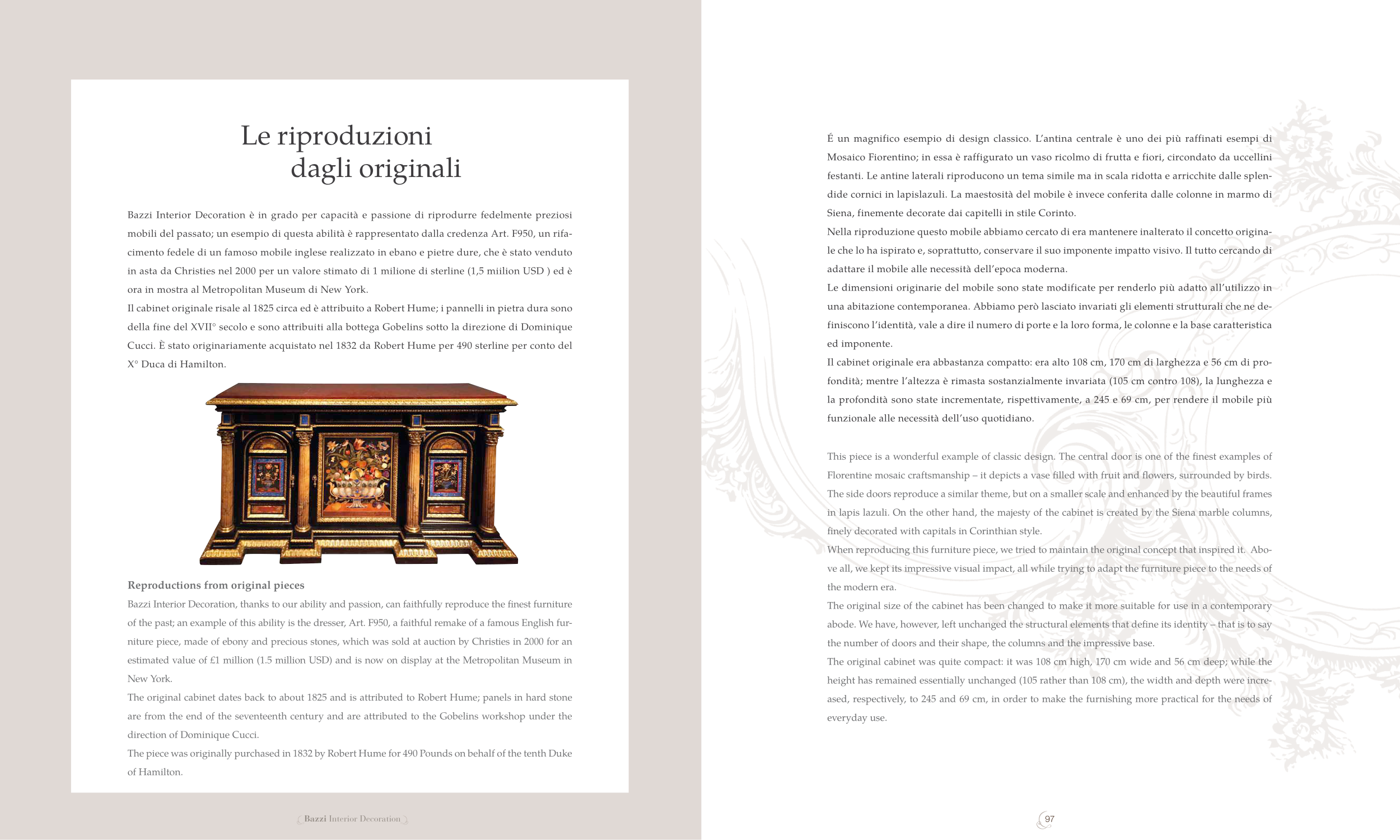Le riproduzioni
dagli originali
Bazzi Interior Decoration è in grado per capacità e passione di riprodurre fedelmente preziosi
mobili del passato; un esempio di questa abilità è rappresentato dalla credenza Art. F950, un rifa-
cimento fedele di un famoso mobile inglese realizzato in ebano e pietre dure, che è stato venduto
in asta da Christies nel 2000 per un valore stimato di 1 milione di sterline (1,5 miilion USD ) ed è
ora in mostra al Metropolitan Museum di New York.
Il cabinet originale risale al 1825 circa ed è attribuito a Robert Hume; i pannelli in pietra dura sono
della fine del XVII° secolo e sono attribuiti alla bottega Gobelins sotto la direzione di Dominique
Cucci. È stato originariamente acquistato nel 1832 da Robert Hume per 490 sterline per conto del
X° Duca di Hamilton.
Reproductions from original pieces
Bazzi Interior Decoration, thanks to our ability and passion, can faithfully reproduce the finest furniture
of the past; an example of this ability is the dresser, Art. F950, a faithful remake of a famous English fur-
niture piece, made of ebony and precious stones, which was sold at auction by Christies in 2000 for an
estimated value of £1 million (1.5 million USD) and is now on display at the Metropolitan Museum in
New York.
The original cabinet dates back to about 1825 and is attributed to Robert Hume; panels in hard stone
are from the end of the seventeenth century and are attributed to the Gobelins workshop under the
direction of Dominique Cucci.
The piece was originally purchased in 1832 by Robert Hume for 490 Pounds on behalf of the tenth Duke
of Hamilton.
É un magnifico esempio di design classico. L’antina centrale è uno dei più raffinati esempi di
Mosaico Fiorentino; in essa è raffigurato un vaso ricolmo di frutta e fiori, circondato da uccellini
festanti. Le antine laterali riproducono un tema simile ma in scala ridotta e arricchite dalle splen-
dide cornici in lapislazuli. La maestosità del mobile è invece conferita dalle colonne in marmo di
Siena, finemente decorate dai capitelli in stile Corinto.
Nella riproduzione questo mobile abbiamo cercato di era mantenere inalterato il concetto origina-
le che lo ha ispirato e, soprattutto, conservare il suo imponente impatto visivo. Il tutto cercando di
adattare il mobile alle necessità dell’epoca moderna.
Le dimensioni originarie del mobile sono state modificate per renderlo più adatto all’utilizzo in
una abitazione contemporanea. Abbiamo però lasciato invariati gli elementi strutturali che ne de-
finiscono l’identità, vale a dire il numero di porte e la loro forma, le colonne e la base caratteristica
ed imponente.
Il cabinet originale era abbastanza compatto: era alto 108 cm, 170 cm di larghezza e 56 cm di pro-
fondità; mentre l’altezza è rimasta sostanzialmente invariata (105 cm contro 108), la lunghezza e
la profondità sono state incrementate, rispettivamente, a 245 e 69 cm, per rendere il mobile più
funzionale alle necessità dell’uso quotidiano.
This piece is a wonderful example of classic design. The central door is one of the finest examples of
Florentine mosaic craftsmanship – it depicts a vase filled with fruit and flowers, surrounded by birds.
The side doors reproduce a similar theme, but on a smaller scale and enhanced by the beautiful frames
in lapis lazuli. On the other hand, the majesty of the cabinet is created by the Siena marble columns,
finely decorated with capitals in Corinthian style.
When reproducing this furniture piece, we tried to maintain the original concept that inspired it. Abo-
ve all, we kept its impressive visual impact, all while trying to adapt the furniture piece to the needs of
the modern era.
The original size of the cabinet has been changed to make it more suitable for use in a contemporary
abode. We have, however, left unchanged the structural elements that define its identity – that is to say
the number of doors and their shape, the columns and the impressive base.
The original cabinet was quite compact: it was 108 cm high, 170 cm wide and 56 cm deep; while the
height has remained essentially unchanged (105 rather than 108 cm), the width and depth were incre-
ased, respectively, to 245 and 69 cm, in order to make the furnishing more practical for the needs of
everyday use.
97
Bazzi Interior Decoration


